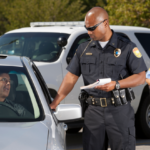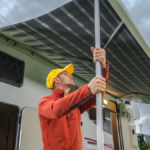You don’t have to be a golfer to own your own golf cart. Golf carts are the preferred way to get around in regions popular with retirees and other people who live in warmer climates — like Florida and Arizona — which are dotted with 55+ communities. They’re also increasingly seen in resort areas, coastal towns, and vacation islands.
Are Golf Carts Having A Moment?
There are lots of reasons people love using golf carts to get around.
- They’re convenient: Golf carts are easy to maneuver and can be driven on streets and paths within a community. They’re just as perfect for golfers playing 18 holes in the hot sun as they are for older adults who may not feel comfortable driving a car but still want to maintain a sense of independence, run errands, and stay connected with others.
- They’re cost-effective: Golf carts are less expensive than cars and easier to maintain, a huge bonus for retirees on a fixed income. And because they run on electric batteries, there’s no fuel to buy, and they produce no emissions, so they’re environmentally friendly.
- They’re accessibility friendly: Golf carts can be modified to suit various mobility issues, like adding hand controls, power steering, and other adaptive equipment.
Being Safe With Golf Carts
While golf carts are a practical and enjoyable way for users to get around, golf courses and retirement communities often have specific rules and guidelines in place for their use. This is especially important because golf cart owners increasingly use their golf carts on public streets.
If that sounds like you or a member of your family or friends, here are a few safety tips you should be aware of:
- Even though it’s not a legitimate automobile, drivers must follow all traffic laws and regulations, including speed limits and traffic signals. And driving on busy roads with a posted speed limit higher than 35 mph should be avoided.
- Golf carts should have seat belts like regular vehicles, and drivers and passengers should always use them.
- If driven at night or in low-light conditions, they should have properly maintained and working headlights and taillights, with reflective paint or stripping on the side so they can be easily seen by other vehicles.
- The golf cart should have brakes, turn signals, and rear and side view mirrors.
Do I Need to Insure My Golf Cart?
Golf carts are generally considered “low-speed vehicles” and are not subject to the same regulations as traditional passenger vehicles. However, in some states, golf carts may be required to be registered and insured if used on public roads or streets. These requirements vary from state to state, so it’s a good idea to check with your state’s department of motor vehicles to determine the specific rules that apply to your golf cart and other vehicles.
If you only use your golf cart on private property, such as on a golf course or in a gated community, you may not be required to have insurance. However, even if street legal golf cart insurance is not legally required, it can still be a good idea to protect yourself and your property with golf cart insurance. This decision can depend on several factors, including where you live, how you use the golf cart, and whether or not you own it outright.
If you took out a loan to buy your golf cart, your lender would want to protect their investment and require you to have it insured. In this case, you may need to provide proof of insurance before taking possession of the golf cart.
What Does A Golf Cart Insurance Policy Cover?
Golf cart insurance policies typically cover damages to the golf cart itself and injuries or damages to other people or property that may occur while operating the golf cart. Some policies may also include coverage for theft, vandalism, and other types of losses.
Typical coverage:
- Physical damage liability can help protect you if you’re sued for damages to property caused by your operation of the golf cart.
- Personal injury liability offers protection from lawsuits over injuries or damages to individuals caused by your operation of the vehicle.
- Medical payments can cover specific medical expenses for you, your passengers, or anyone struck by the golf cart due to your vehicle operation.
- Collision coverage covers damages to the golf cart resulting from an accident, theft, or other covered events.
- Uninsured motorist covers injuries or damages if you’re involved in an accident with an uninsured (or underinsured) driver while operating your golf cart.
- Personal property covers anything damaged, stolen, or lost while stored in the golf cart, such as golf clubs or electronic devices.
- Comprehensive coverage will help protect you if your golf cart is stolen or damaged by hail storms, floods, lightning, or natural fires.
What Does Golf Cart Insurance Cost?
The cost of golf cart insurance depends on the value of the cart, its age, where it is typically used and stored, and the coverage limits you choose. Depending on these and other factors, you can generally expect to pay anywhere from less than a hundred dollars to a few thousand dollars per year. To get a more accurate estimate of what you might pay to insure your golf cart, it’s a good idea to get policy quotes from several insurance companies – something we can help you with.
Can I Add A Golf Cart To My Car Insurance?
Most, but not all, standard car insurance policies will not cover golf carts. Drivers will typically need to purchase a separate policy specifically designed for insuring golf carts. This type of policy will provide coverage for damages to the golf cart itself and liability coverage in case you cause an accident while operating the cart.
A Final Word About Golf Cart Insurance
It bears repeating: if you aren’t sure whether or not you need golf cart insurance where you live, check with your state’s department of motor vehicles and with your lender (if applicable).
Keep in mind that the specific coverage options and limits included in a golf cart insurance policy may vary depending on the insurer and the policy you choose. It’s a good idea to carefully review the policy details and consider your specific needs and risks before deciding on a policy.
If that sound’s like a lot to remember, you came to the right place. The Guided Solutions team can help evaluate whether you need insurance for your cart, compare available rates, and find a policy that fits your needs. Let’s get started.









